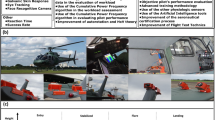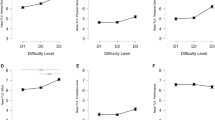Abstract
Simulated 4-h flights were carried out in a realistic model of a three-row, 21-seat section of an aircraft cabin that was reconstructed inside a climate chamber. Twenty-nine female subjects, age 19–27 years, were split into two groups; each group was exposed to four conditions: two levels of ozone (<2 and 60–80 p.p.b.) at two outside air supply rates (2.4 and 4.7 l/s per person). A companion study measured the chemicals present in the cabin air during each of the simulated flights. The subjects completed questionnaires to provide subjective assessments of air quality and symptoms typical of complaints experienced during actual flight. Additionally, the subjects’ visual acuity, nasal peak flow and skin dryness were measured. Based on self-recorded responses after 3¼ h in the simulated aircraft cabin, they judged the air quality and 12 of the symptoms (including eye and nasal irritation, lip and skin dryness, headache, dizziness, mental tension, claustrophobia) to be significantly worse (P<0.05) for the “ozone” condition compared to the “no ozone” condition. The results indicate that ozone and products of ozone-initiated chemistry are contributing to such complaints, and imply previously unappreciated benefits when ozone is removed from the ventilation air supplied to an aircraft cabin.
This is a preview of subscription content, access via your institution
Access options
Subscribe to this journal
Receive 6 print issues and online access
$259.00 per year
only $43.17 per issue
Buy this article
- Purchase on Springer Link
- Instant access to full article PDF
Prices may be subject to local taxes which are calculated during checkout




Similar content being viewed by others
References
ASHRAE (American Society of Heating Refrigerating Air-Conditioning Engineers). Ventilation for Acceptable Indoor Air Quality, ANSI/ASHRAE Standard 62.1-2004. ASHRAE, Atlanta, GA, 2004.
Bach M. The Freiburg visual acuity test – automatic measurement of visual acuity. Optom Vis Sci 1996: 73(1): 49–53.
de Ree H., Bagshaw M., Simons R., and Brown R.A. Ozone and relative humidity in airline cabins on polar routes: measurements and physical symptoms. In: Nagda N.L. (Ed.). Air Quality and Comfort in Airliner Cabins: ASTM STP 1393. American Society for Testing and Materials, West Conshohocken, PA, 2000, pp. 243–258.
Fanger P.O. Thermal Comfort: Analysis and Applications in Environmental Engineering. R.E. Krieger Publishing, Malabar, FL, 1982.
Horváth M., Bilitzky L.D., and Hüttner J. Ozone. In: Topics in Inorganic and General Chemistry, vol. 20. Elsevier Science Publishers, Amsterdam, 1985.
Nagda N.L., and Koontz M.D. Review of studies on flight attendant health and comfort in airliner cabins. Aviat Space Environ Med 2003: 74(2): 101–109.
NRC (National Research Council) Committee on Air Quality in Passenger Cabins of Commercial Aircraft. The Airliner Cabin Environment and the Health of Passengers and Crew. National Academy Press, Washington, DC, 2002.
SAE International (Society of Automotive Engineers International). Ozone in high altitude aircraft. Aerospace Information Report, SAE AIR 910 Rev. B. Society of Automotive Engineers, Warrendale, PA, 2000.
Siegel S., and Castellan N.J. Nonparametric Statistics – for the Behavioral Sciences, 2nd edn. McGraw-Hill, New York, 1988.
Spengler J.D., Ludwig S., and Weker R.A. Ozone exposures during trans-continental and trans-Pacific flights. Indoor Air 2004: 14 (Suppl 7): 67–73.
Spicer C.W., Murphy M.J., Holdren M.W., Myers J.D., MacGregor I.C., Holloman C., James R.R., Tucker K., and Zaborski R. Relate air quality and other factors to comfort and health symptoms reported by passengers and crew on commercial transport aircraft (Part I). ASHRAE Report 1262-TRP. American Society for Heating, Refrigerating, and Air Conditioning Engineers, Atlanta, GA, 2004.
Strøm-Tejsen P., Wyon D.P., Lagercrantz L., and Fang L. Passenger evaluation of the optimum balance between fresh air supply and humidity from 7-h exposures in a simulated aircraft cabin. Indoor Air 2007: 17(2): 92–108.
Strøm-Tejsen P., Wyon D.P., ukowska D., Jama A., and Fang L. Occupant evaluation of 7-h exposures in a simulated aircraft cabin – Part 2: thermal effects. In: Proceedings of Indoor Air 2005, Beijing, the 10th International Conference on Indoor Air Quality and Climate, Vol. I (1), 2005, pp. 46–51.
Strøm-Tejsen P., Zukowska D., Fang L., Space D.R., and Wyon D.P. Effects of gas-phase adsorption air purification on passengers and crew in simulated 11-h flights. In: Proceedings of Healthy Buildings 2006, Lisbon, The 8th International Conference, Vol. III, 2006, pp. 287–292.
Sun Y.X., Fang L., Wyon D.P., Wisthaler A., Lagercrantz L., and Strøm-Tejsen P. Experimental research on photocatalytic oxidation air purification technology applied to aircraft cabins. Build Environ 2007 doi: 10.1016/j.buildenv.2006.06.036.
Tamás G., Weschler C.J., Bakó-Biró Z., Wyon D.P., and Strøm-Tejsen P. Factors affecting ozone removal rates in a simulated aircraft cabin environment. Atmos Environ 2006: 40(32): 6122–6133.
US EPA (US Environmental Protection Agency). Air Quality Criteria for Ozone and Related Photochemical Oxidants (Final), EPA/600/R-05/004aF-cF. US Environmental Protection Agency, Washington, DC, 2006.
US EPA (US Environmental Protection Agency). National Ambient Air Quality Standards (NAAQS) 2007: http://epa.gov/air/criteria.html(last accessed 9 May 2007).
Wargocki P., Wyon D.P., Baik Y.K., Clausen G., and Fanger P.O. Perceived air quality, sick building syndrome (SBS) symptoms and productivity in an office with two different pollution loads. Indoor Air 1999: 9(3): 165–179.
Weschler C.J. New directions: ozone-initiated reaction products indoors may be more harmful than ozone itself. Atmos Environ 2004: 38(33): 5715–5716.
Weschler C.J. Ozone in indoor environments: concentration and chemistry. Indoor Air 2000: 10(4): 269–288.
Weschler C.J. Ozone's impact on public health: contributions from indoor exposures to ozone and products of ozone-initiated chemistry. Environ Health Perspect 2006: 114(10): 1489–1496.
Weschler C.J., Wisthaler A., Cowlin S., Tamás G., Strøm-Tejsen P., Hodgson A.T., Destaillats H., Herrington J., Zhang J., and Nazaroff W.W. Ozone-initiated chemistry in an occupied simulated aircraft cabin. Environ Sci Technol 2007 (submitted).
WHO (World Health Organization). WHO Air Quality Guidelines for Particulate Matter, Ozone, Nitrogen Dioxide and Sulphur Dioxide – Global Update 2005 – Summary of Risk Assessment. WHO press, Geneva, 2006.
Wisthaler A., Strøm-Tejsen P., Fang L., Arnaud T.J., Hansel A., Märk T.D., and Wyon D.P. PTR-MS assessment of photocatalytic and sorption-based purification of recirculated cabin air during simulated 7-h flights with high passenger density. Environ Sci Technol 2007: 41(1): 229–234.
Wisthaler A., Tamás G., Wyon D.P., Strøm-Tejsen P., Space D., Beauchamp J., Hansel A., Märk T.D., and Weschler C.J. Products of ozone-initiated chemistry in a simulated aircraft environment. Environ Sci Technol 2005: 39(13): 4823–4832.
Acknowledgements
We thank David P. Wyon and Gyöngyi Tamás, each of whom contributed to the completion of this project, and William W. Nazaroff for useful comments on the earlier versions of the paper. This work has been supported by the Danish Technical Research Council (STVF) as part of the research programme of the International Centre for Indoor Environment and Energy at the Technical University of Denmark and by the US Federal Aviation Administration (FAA) Office of Aerospace Medicine through the Air Transportation Center of Excellence for Airliner Cabin Environment Research (ACER), Cooperative Agreement 04-C-ACE-UMDNJ. Although the FAA has sponsored this project, it neither endorses nor rejects the findings of this research.
Author information
Authors and Affiliations
Corresponding author
Rights and permissions
About this article
Cite this article
Strøm-Tejsen, P., Weschler, C., Wargocki, P. et al. The influence of ozone on self-evaluation of symptoms in a simulated aircraft cabin. J Expo Sci Environ Epidemiol 18, 272–281 (2008). https://doi.org/10.1038/sj.jes.7500586
Received:
Accepted:
Published:
Issue Date:
DOI: https://doi.org/10.1038/sj.jes.7500586
Keywords
This article is cited by
-
Symptoms related to new flight attendant uniforms
BMC Public Health (2017)
-
Mass balance modeling of building recirculation rates and filtration efficiencies effects on secondary organic aerosols derived from ozone-initiated chemistry
Building Simulation (2014)



